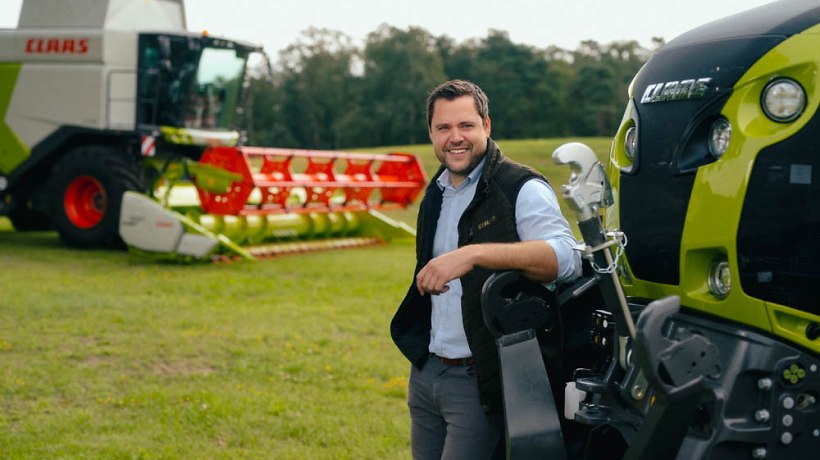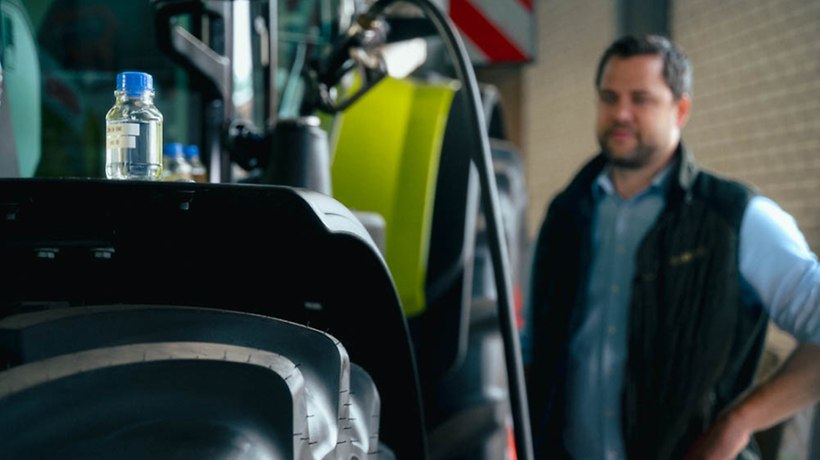

Targeting greater climate neutrality with HVO
Internal combustion engines are often at the heart of debates surrounding climate change and sustainability. “It’s not the engine that’s the problem, it’s the fossil diesel,” explains Patrick Ahlbrand, product strategist at CLAAS.
Although electric vehicles have become an established alternative to ICE vehicles for road use, they won’t be a viable option for energy-intensive agricultural applications for the foreseeable future, for one simple reason: a battery-powered forage harvester, for example, would be twice as big, twice as heavy and therefore cause much more damage to the soil. The reason behind this is purely down to physics: batteries have a much lower energy density than liquid fuels.
Download Whitepaper "Efficient Farming"
Direct diesel replacement from leftover and waste materials
One promising approach to the decarbonisation of agriculture is therefore the use of sustainable liquid fuels such as HVO (hydrotreated vegetable Oil). This sustainable fuel is a direct, low-investment way to significantly reduce CO2 emissions from agriculture – without any modifications, investments or new machinery.
HVO is produced via the chemical treatment of waste products such as plant residue or used cooking oil. Unlike traditional biodiesel made from rapeseed or other vegetable oils, this fuel does not compete with the production of food or animal fodder. This reduces CO2 emissions by up to 90 per cent. When the fuel is burned, it only releases into the air the same CO2 that the plants had previously extracted from the air as they grew.
Advantages in agricultural technology
In comparison with the use of electric and hydrogen propulsion, HVO is uncomplicated and cost-efficient, especially for applications that demand high performance and lengthy operating hours. Battery-driven vehicles are not currently suitable in this regard. “In the future, agriculture will continue to be dependent on large, effective and efficient agricultural machinery with internal combustion engines in view of the shortage of skilled labour and the need to increase productivity,” believes CLAAS expert Ahlbrand. Battery power is an alternative for small tractors up to 150 hp. “However, for medium to high power machinery, sustainable liquid fuels will remain essential,” says Ahlbrand.
In terms of the overall economy, HVO already offers opportunities: if a medium-sized agricultural business switches completely from fossil diesel to HVO, no investment in infrastructure is required at all. They can simply continue to use their existing diesel pumps. Whether fossil or sustainable fuel is used, there is no need for a second pump. However, “depending on the design, a cost of around €8,000 is still manageable,” says Ahlbrand, comparing this to “the €40,000 that farmers plough into the installation of charging infrastructure for electric vehicles – and many times more for a hydrogen refuelling facility.”

HVO is still unknown
“HVO is almost unknown to the general public because it is not yet permitted to fill up with this fuel at pumps in Germany,” explains Patrick Ahlbrand. However, that is soon set to change because amendments to legislation that will allow HVO to be offered at German filling stations from 2024 have already been announced. “Only then will it really be visible to the public and awareness will be raised,” Ahlbrand is certain.
The question of cost still remains, which has a double impact on farmers: the price of HVO is linked to the price of diesel and is currently around 15 cents higher. “On top of that, farmers are currently subsidised to fill up with fossil diesel,” explains Patrick Ahlbrand. This is because the agricultural diesel allowance means that businesses receive 21.48 cents back from the government for every litre of diesel – but only for fossil fuel, not HVO.
Sending the wrong political signal to the farming industry
It’s a political misconstruction, says the CLAAS strategist: “It would make sense to include HVO, a sustainable fuel, in the agricultural diesel subsidies,” says Ahlbrand. Why isn’t that the case? “Because up to now, politicians have favoured drive solutions that do not produce any local emissions. That does not apply to HVO. However, if you look at all the traffic on the roads, it does reduce CO2 emissions by up to 90 per cent,” says the expert.
The consequence of this is that farmers are faced with the question of whether they want to continue paying around 36 cents less per litre for diesel, or use the more sustainable fuel HVO, which is still awaiting political support. “Farmers are pretty good at maths,” says Ahlbrand in an appeal to policymakers.
Nevertheless, we are already starting to see success stories: winemakers, vegetable growers and dairy farmers who intentionally opt to use HVO as a more sustainable fuel will reduce their CO2 emissions and can therefore market their products as being more sustainable, too.
More sustainable from the moment they leave the factory with HVO
The commitment of CLAAS is already paying dividends for the environment: since October, all agricultural machinery built to current emissions standards in the plants in Harsewinkel in Germany and Le Mans in France has been delivered with a tank of HVO. This more sustainable delivery standard is saving 2,500 tonnes of CO2 – and that’s every year.
“Whether the farmer then fills up with HVO again, fossil diesel or a mixture of both doesn’t matter to the machine, it’s entirely up to the farmer,” says product strategist Patrick Ahlbrand.






